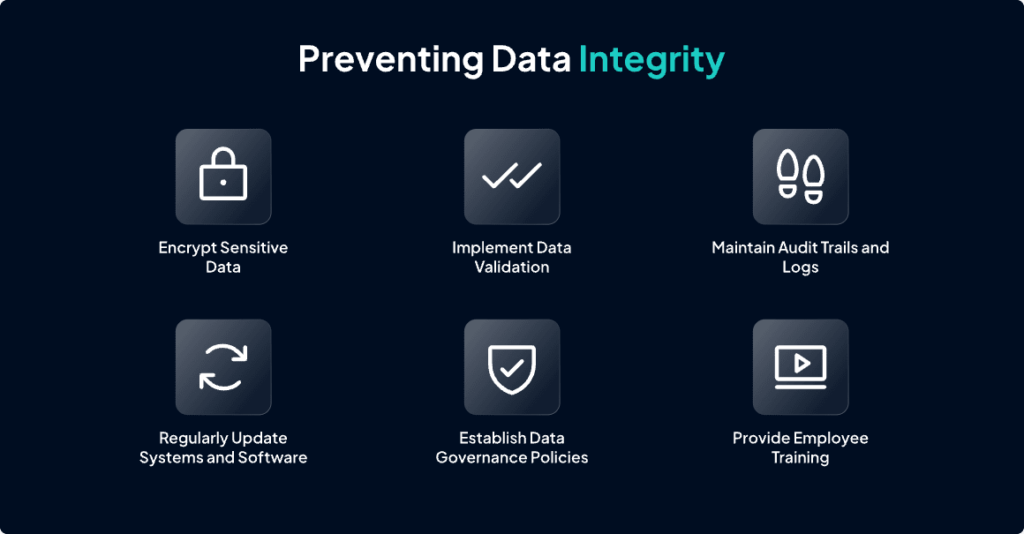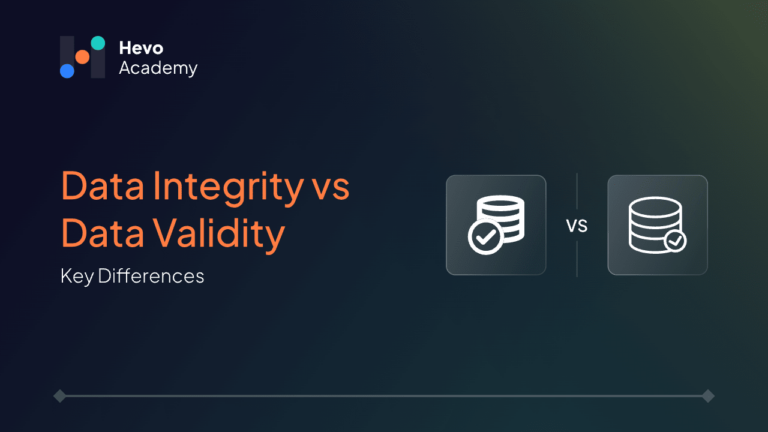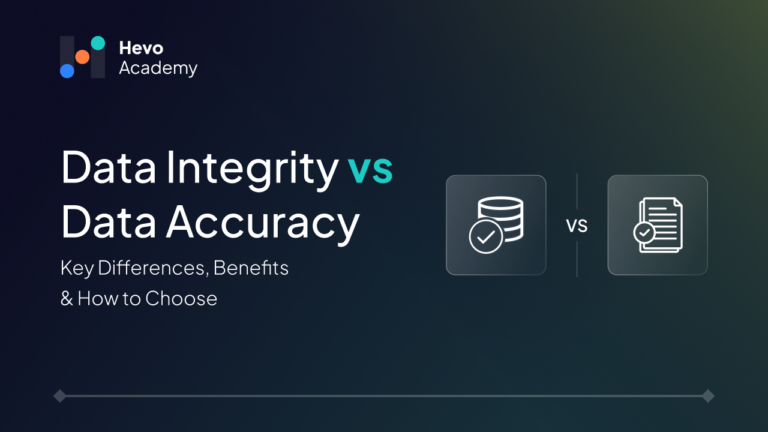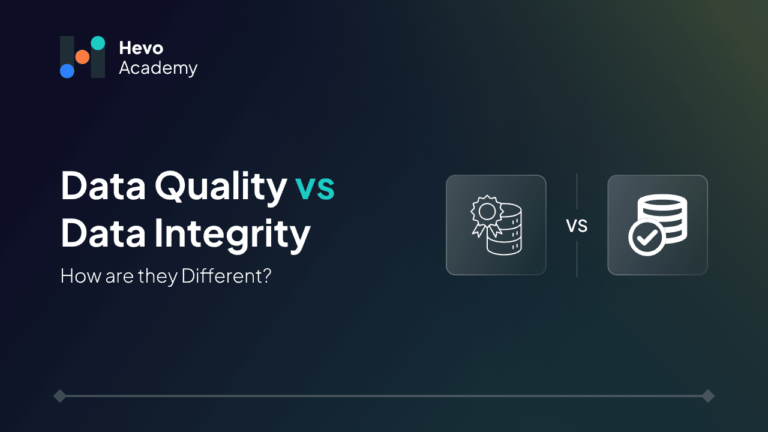According to Gartner, poor data can cost organizations an average of $12.9 million annually. It thus becomes absolutely essential for organizations to ensure data integrity. However, they often face challenges around the accuracy, consistency, and reliability of the data, which can ultimately lead to flawed analysis and incorrect decision-making. In this blog, we will delve into data integrity, its benefits, common data integrity issues, along with some strategies that can be used to resolve them.
Table of Contents
What is Data Integrity?
According to McKinsey, data-driven organizations are 23 times more likely to outperform their competitors in customer acquisition and up to 19 times more profitable. With so much reliance on data, imagine the effect a small error or ambiguity in the dataset can have on the business!
This is where data integrity becomes essential. It ensures that the data used for decision-making is accurate, complete, original, and valid throughout its entire lifecycle. It also guarantees that the data remains unaltered during storage, processing, and transit. By implementing robust measures, we can maintain data integrity and ensure that the data remains reliable for analysis.
Benefits of Data Integrity
Let us first see why data integrity is important for organizations all over the world:
- Enhanced decision-making: When data is reliable and consistent, businesses can be assured that their decisions are based on accurate information, hence leading to better outcomes.
- Customer Trust: Accurate data builds trust among stakeholders, customers, and partners and strengthens the organization’s reputation and credibility.
- Operational Efficiency: Consistent data reduces errors and anomalies, improving the end-to-end data workflow and overall system performance.
- Cost Savings: You can prevent data corruption and loss by ensuring data integrity. This reduces the need for data recovery efforts and curbs potential financial losses due to flawed business decisions.
- Regulatory Compliance: Data integrity helps organizations meet legal and industry standards, reducing the risk of non-compliance penalties.
Common Data Integrity Issues

Several issues can compromise data integrity, leading to significant consequences. Some of the common ones are as mentioned below:
- Lack of Data Integration: There can be anomalies and inconsistencies when data from multiple sources is not integrated correctly. For example, a company using separate systems for sales and customer service might have conflicting customer information, leading to poor customer experience.
- Manual Data Entry Errors: Human errors during data entry can lead to inaccuracies in data. A notable example is Samsung Securities’ 2018 incident, where 2.8 billion company shares were issued mistakenly instead of a 2.8 billion Korean Won dividend, causing a temporary market value surge and reputational damage.
- Multiple Analytics Tools: Utilizing multiple analytics platforms without proper synchronization can lead to inconsistent data. This can result in conflicting analytics reports, making it challenging for organizations to make informed decisions.
- Poor Auditing Practices: Inadequate data audits can allow errors and inconsistencies to creep in. For example, if a financial institution fails to audit transaction records regularly, fraudulent activities might go undetected, leading to financial losses and legal actions.
- Legacy Systems: Old legacy systems may lack modern data integrity features. For example, a healthcare provider using an old health record system might face data corruption issues, which could impact patient care due to inaccessible or inaccurate records.
- Inadequate Data Security: Poor security measures can lead to unauthorized data access. For example, cybersecurity attacks or data breaches can expose sensitive information, resulting in significant financial and reputational damage.
- Data Silos: Data stored in silos or not shared across departments can lead to incomplete analysis. For example, if a company’s sales data is not accessible to the marketing team, the marketing strategies may not align with the actual sales trends, leading to ineffective campaigns.
Explore data integrity best practices and discover key strategies to maintain high-quality data across systems.
How to Prevent Data Integrity Issues?
Now that you know the impact of data integrity issues let us explore some strategies to prevent these issues:
- Implement Data Validation and Verification: You should establish automated checks to ensure data accuracy during ingestion and processing, ensuring it meets the predefined criteria.
- Control Access Permissions: You should follow the principle of least privilege to restrict data access based on user roles, hence preventing unauthorized changes and maintaining data consistency.
- Encrypt Sensitive Data: You should utilize encryption techniques to protect data from unauthorized access while it is at rest and in transit.
- Conduct Regular Data Backups: You should take frequent data backups to safeguard against data loss or corruption. This also ensures that the data can be retrieved whenever needed.
- Maintain Audit Trails and Logs: You must keep detailed records of data access and modifications to monitor activities and identify potential integrity breaches.
- Automate Data Collection Processes: You can reduce manual data entry by implementing automated systems, thus minimizing human errors and enhancing accuracy and reliability.
- Regularly Update Systems and Software: You should ensure that all systems and software are up-to-date to prevent any vulnerabilities that could compromise the data integrity.
- Implement Redundancy Measures: Yoy should implement data redundancy by storing data in multiple locations to prevent any loss from system failures.
- Establish Data Governance Policies: To ensure data integrity, you should develop and enforce data governance and management policies.
- Provide Employee Training: You must provide relevant training on proper data handling practices and the importance of data integrity.
When do Data Integrity Issues Occur?
Data integrity issues arise when data becomes inaccurate, inconsistent, or corrupted during its lifecycle. Some of the common scenarios where such issues may occur are:
- Human Errors: Mistakes during manual data entry, accidental deletes, or incorrect configurations can compromise data integrity.
- Transmission Errors: Data can become corrupted during transmission between systems due to network issues or incompatible formats.
- Software Bugs and Viruses: Malicious software or coding errors can alter or corrupt the data, leading to data integrity issues.
- Hardware Failures: Failures in storage devices or compute servers can also result in data corruption or loss.
- Lack of Data Integration: Inconsistent data across multiple systems and poor synchronization among them can lead to various anomalies in data.
- Poor Auditing Practices: Infrequent or inadequate data audits can allow errors and inconsistencies to creep in, thus affecting data integrity.
Data Integrity Tools
Data integrity tools help organizations detect corrupt data, ensure compliance, and prevent unauthorized modifications. They help businesses protect sensitive information and enhance decision-making by ensuring accurate data. Here are five popular tools that are used to maintain data integrity:
- Tripwire: It is a file integrity and change monitoring tool that detects unauthorized and suspicious changes in files and directories with real-time data and security automation. It is widely used for compliance in industries requiring strict security measures, such as finance and healthcare.
- IBM InfoSphere QualityStage: It is a robust data quality and integrity solution that helps organizations clean, standardize, and validate data across multiple sources. It also helps them investigate, cleanse, and manage data to gain more information and value.
- Talend Data Quality is a powerful tool for maintaining high-quality data integrity for big data platforms. It offers data profiling, cleansing, and validation capabilities.
- DataCleaner: It is an open-source tool with a strong data profiling engine for discovering and analyzing data quality. It allows you to profile and cleanse the data by uncovering patterns, missing values, and other characteristics.
- SolarWinds Database Performance Analyzer: This tool provides real-time database monitoring, ensuring data accuracy and consistency by identifying performance issues and anomalies that may lead to data corruption or loss.
Wrapping It Up
Maintaining data integrity is essential for organizations to make informed business decisions and maintain customer trust. Data must be accurate, complete, reliable, and valid to be effectively utilized by businesses. Inaccurate data can result from integrity issues such as human errors, hardware or software failures, and security breaches. This can impact analytics, leading to poor decision-making, flawed strategies, and reputational damage.
These issues can be mitigated by implementing robust validation checks, automating manual processes, enforcing strict access controls, and conducting regular audits. By addressing potential data integrity challenges, organizations not only enhance decision-making and customer trust but also improve operational efficiency and ensure regulatory compliance.
Frequently Asked Questions
1. What are data integrity issues?
Data integrity issues refer to the problems that compromise the accuracy, consistency and reliability of data. Some common data integration issues are manual data entry errors, software incompatibility or misconfigurations leading to data loss, data corruption due to inefficient storage and transmission, unauthorized data access, and outdated data.
2. What are the 5 principles of data integrity?
Data integrity has 5 major principles, also known as the ALCOA principle. It means that the data must be Attributable (data entered should be easily traced back), Legible (data can be easily read, without misunderstanding), Contemporaneous (collection time of the data should correspond to the time of recording data), Original, and Accurate.
3. How do you resolve data integrity issues?
We can resolve data integrity issues by implementing data validation checks, automating manual data collection to minimize human errors, establishing strict access controls to prevent unauthorized changes, regularly backing up data and maintaining audit trails to monitor changes. It is also crucial to provide relevant training to the employees on proper data handling practices.





